
The euro dropped below $1 on July 13. The dollar has jumped by 14 per cent against the euro since the start of the year.
Increasing inflation in the eurozone and rising interest rates in the United States are two reasons being cited for the development, global news networks reported. The eurozone inflation averaged 8.6 per cent in June, with 14 small euro area economies experiencing above-average inflation. Only five eurozone economies are below this average.
The US economy is also much less hit by the Ukraine war than Europe. A weakened euro can benefit euro area exports, particularly for Germany and France.
The European Central Bank (ECB) has announced that it will hike interest rates this month for the first time since 2011, as the eurozone inflation rate sits at 8.6 per cent.
Adding to the fears of a recession in the eurozone is a heightened cut in Russian gas supplies to Europe. Russian energy giant Gazprom on July 11 started 10 days of maintenance on its Nord Stream 1 pipeline, with Germany and other European countries waiting anxiously to see if the gas supply gets restarted. Most analysts are not optimistic about Gazprom resuming the gas supply.
ALCHEMPro News Desk (DS)
Receive daily prices and market insights straight to your inbox. Subscribe to AlchemPro Weekly!